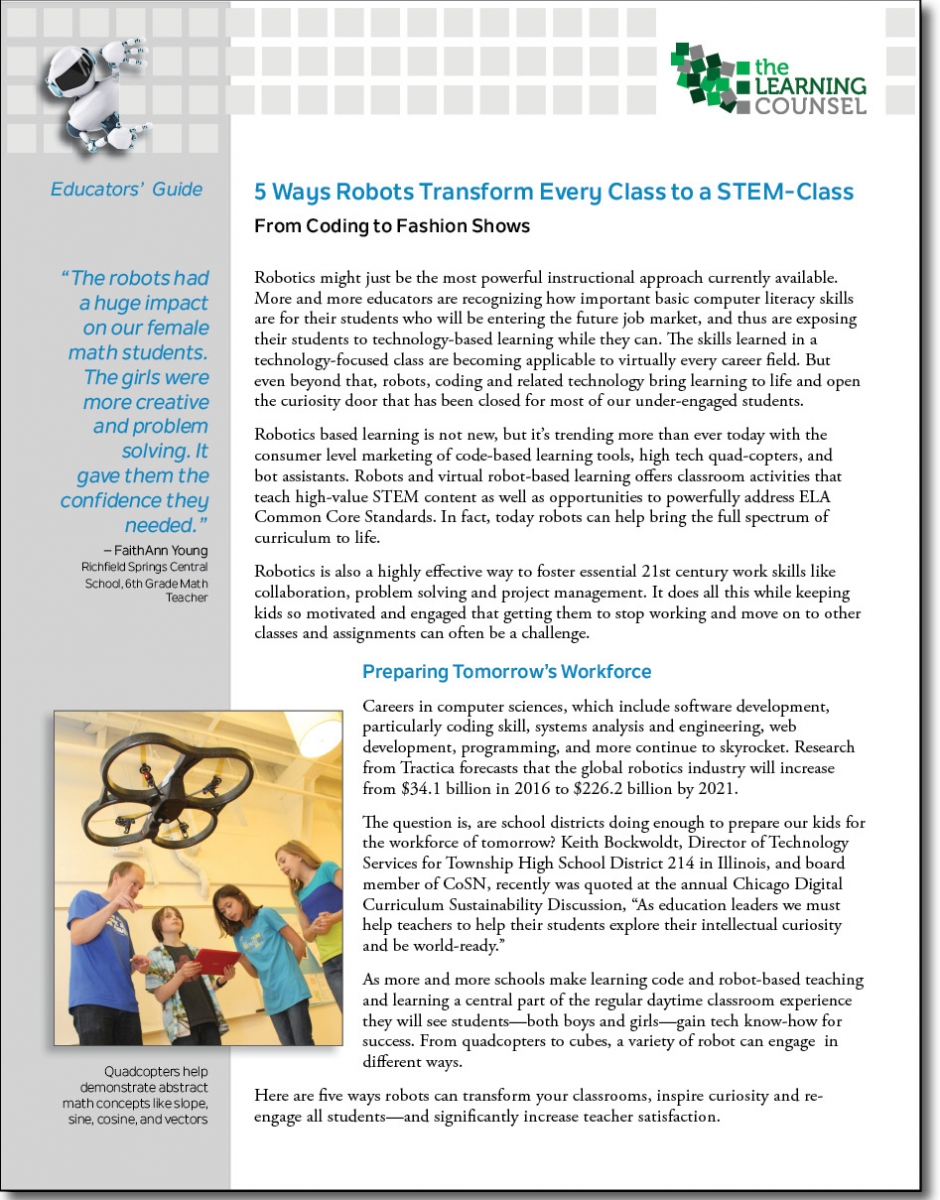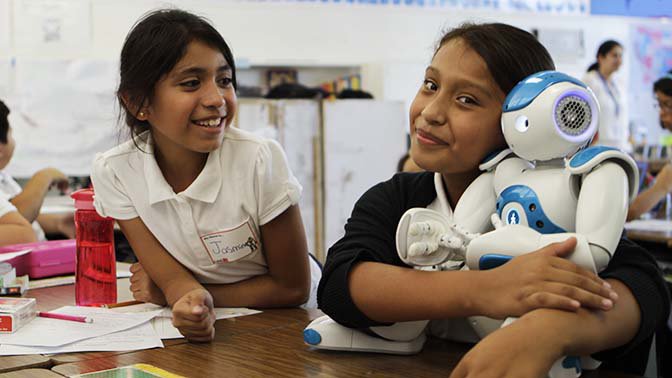The Learning Counsel sat down with the CEO of RobotLAB, Elad Inbar, to talk about STEM, robotics and the ways in which schools can use technology to reimagine classroom learning. It turns out that there are many types of robots and more ways to utilize them for cross-curricular study than one would first consider.
Join us on video, or read the story below.
Learning Counsel: At first most would consider that a robot is strictly for STEM learning, and also an extra-curricular activity, but is it more than that?
Elad Inbar: Yes. I hear that all the time. If you look in the past 10 years, for example, you would see robotics in an after-school program and in all kinds of competitions, “Go and build your robots” and so on which is great fun for the kids but the connection to the core subjects of learning that we want them to learn is very loose.
What we are doing with this technology is, bring it to the center of learning, to the center of the classroom. Showing our children that math is not just an abstract thing, equations are not just for the sake of equations. This is how our world works and they can work on this Robot in order to figure it out.
This is a huge shift from just robots for fun, for the sake of having robots because they are a cool addition to school offerings. Robots can enrich the classroom and engage kids across many subjects.
LC: Can you share an example of what you mean when you say it’s the center of learning. To take the abstract and make it very real to a child?
EI: Let’s take an example from a math classroom. We want the students to understand, let’s say, a transformation of an equation in three-dimensional space. In high school math, they have the x, the y and the z. Students don’t “get” the z, this diagonal line doesn’t mean depth for most of the students. What we are doing is showing them. If for example, we have a triangle over here. (manipulates the robots bent elbow to show a triangle with the upper arm, lower arm and a line from the hand to the shoulder to form a triangle) We can transform the triangle this way (moving the hand back and forth to change the dimensions of the triangle) but we can actually transform it on this angle as well (swings the arm around in front of the robot to show the z axis) and this transformation will be on the depth, on the z axis. So, if we have the x and the y, this will be our z.
Then the kids are like “Oh, that makes sense, this is how the world works.” So, we take the kids from the two-dimensional world on the board into the real world and then they can apply the learning right on the robot. This is in high-school level.
In the elementary level, we have STEM plus ELA oriented activities and kids can make the robot stand up and tell their story so they become story tellers. So, instead of taking an essay of, like, 500 words – “Write it by Friday or else”, the kids are working with this robot and making the robot stand up and tell their story. And when they do that, with sound effects and animation and so on, they learn much more than the story-telling, they learn that the story has a beginning, middle and end, and they learn how to spell correctly. If you don’t spell correctly, the robot won’t pronounce it correctly so, as an example, “Great” is “GR8” in text language. But that won’t cut it for the robot. If you want the robot to say the words correctly, you have to spell correctly. So it opens a wide range of learning opportunity at the core of the subject that you want them to learn.
LC: Your work is clearly more than just a cool robot. Tell us about the curriculum that comes with a “RobotLAB” package.
EI: The robots are the tools. They are the reason to learn. For lack of a better word, we “trick” them to learn by using the robots as an engager. The learning is a sort of “blended learning” – with the robots and online.
RobotLAB provides a Learning Management System that has all the activities, all the lesson plans loaded on it. It has the teacher side and the student side. On the teacher side there’s the lesson plan, the activity and how you spark the discussion in the classroom and how to spark the curiosity and so-on and on the student side they need to fill the assessment and they go through the learning experience.
By working with the robot and the platform the students and teachers can collect data. For example, if I move the arm of the robot, I can collect the x and y coordinates and I can see how it affects a triangle which is represented by the position of the arm. As another example, if I want to write a story, I can just do it on the online platform and the robot stands up and tells my story. So it’s a blended learning, online and offline and we keep going back and forth because we want to show the student that it’s actually the same.
LC: Please give us an understanding of your story and how it evolved from cool robots to the curriculum and the teaching and learning system you have today.
EI: Of course. When we started, it was like “What an amazing technology, every classroom has to have it!” That’s great. But, now, you have this technology in classrooms and, now what?
We realized we needed a curriculum. So, we created the curriculum and the activities so we deliver the technology plus the curriculum. That was still not enough because the teachers didn’t know what to do with it. So, we need to take them and show them, this robot with this activity is exactly what you’re teaching on “day x.”
This connection—the full combination of curriculum plans, teacher support and the robotics tools—is something that no-one else is doing with this type of technology. “When you teach, quadratic equations, here’s the activity that can bring it to life using this technology.” “When you teach biology, here’s a different activity that can do that,” and so on.
So we map all our activities with the school curriculum and we help them focus on the subjects that they need to enhance their learning. Everything is available on our learning management platform which collects all the data, can submit everything back to the SAS (Statistical Analysis System) so it’s aligned with the way the school works in collecting data and grading the students and so on.
LC: Anything else you’d like to share?
EI: Just one thing. I attended one of your Learning Counsel Discussion events. These types of activities are important for both sides—educators and industry providers like me. Hearing LeiLani laying out the map; “Hey, this is the mountain, this is the valley, these are the pitfalls, this is where everyone is going and this is where you are at”, kind of like an outsider view was very, very helpful. In the professional development we are doing across the country with schools, we see them struggling and shooting in all directions. Schools are trying to get their hands on technology, on digital stuff because they hear buzzwords and they’re trying to stand in front of the board and say, “Yes, we do that!” It’s not going anywhere and you feel it. You feel the confusion.
What LeiLani laid-out is “This is what’s going to happen, this is what is happening, this is what needs to happen if you’re going to solve this tangled situation which you are at right now”. I really think this is like putting a mirror in front of us all and saying, “Look at the mirror”, this is the picture, this is what it is, now let’s take it somewhere else”.
 Gain further perspective about STEM solutions in education and ideas on how to implement coding, programming and robotics to engage your students and support instruction.
Gain further perspective about STEM solutions in education and ideas on how to implement coding, programming and robotics to engage your students and support instruction.










